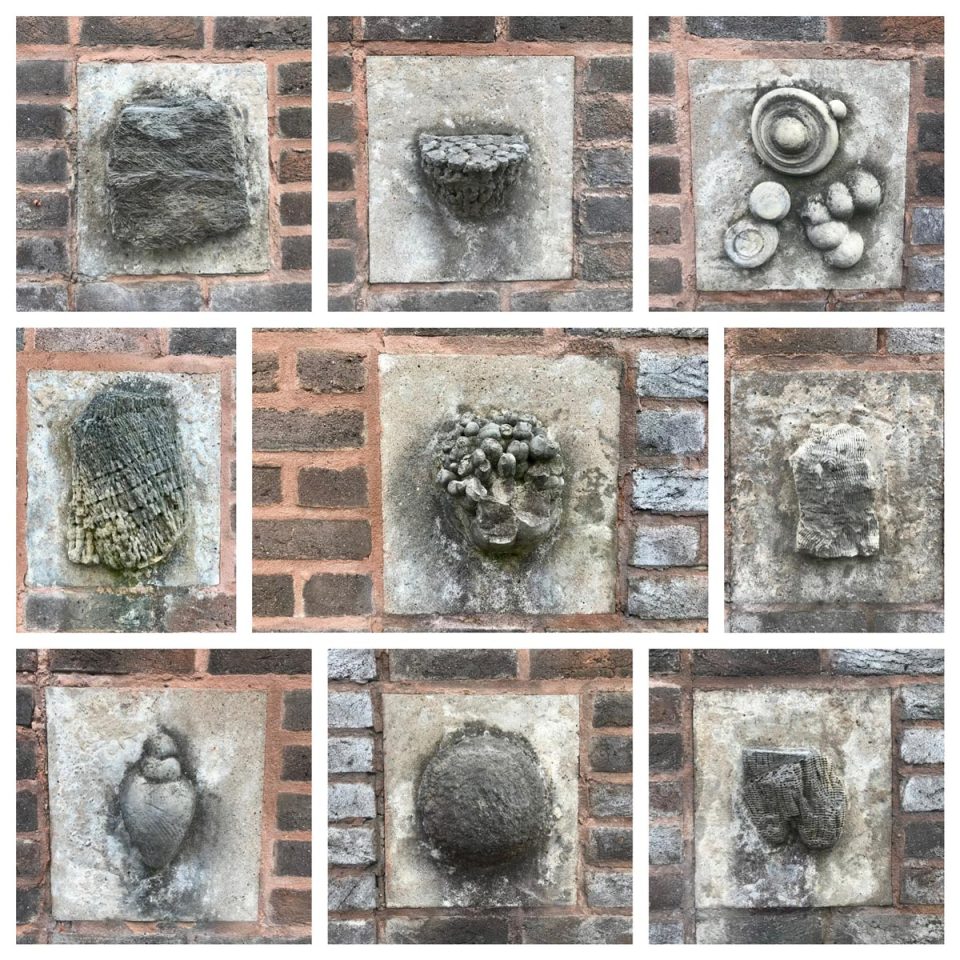Standing on a prominent site close to the city centre, there has been a college on University Park main campus since the 1920s. The campus welcomes visitors to walk around its grounds.
Access is via three main gates: off the A464 to the west, the A6005 to the south and the A52 to the north. Parking is free at weekends and in the evenings; at all other times you can use the (free) lakeside car park (south entrance) or follow the signs to the visitor car park (fee payable).

Curious fossils set into a wall at University of Nottingham. BGS © UKRI.
The lake sits in Highfields Park, a 121-acre public space owned by the city council adjacent to the University Park campus. The park lake, which was excavated to provide gravel for the adjacent A6005 road, has boats for hire in the summer and a cascading waterfall with stepping stones towards the western end. Towards the east of the lake there is a children’s play area, mini golf course, pavilion and the Lakeside café and arts centre.
Close to the lakeside car park is the School of Psychology building (formerly the department of geology). At the entrance to the building is a wall of concrete and fossils set into the brickwork. There is no information on these artefacts but some look like fossil limestone corals, possibly from the Lower Carboniferous rock of the Peak District. They are definitely worth a look!

Chester Formation sandstone at Highlands Park, University of Nottingham. BGS © UKRI.
From the car park, taking the footpath to the north of the lake, the grassy slope is underlain by Mercia Mudstone. Further along the path there is a buttressed terrace of Carboniferous sandstone. The terrace supports the foundations of the magnificent Trent Building, which is built on the soft Mercia Mudstone.
The Trent Building is built of Portland Stone, a popular limestone building material from the Jurassic, quarried on the Isle of Portland. A close look at the Portland Stone reveals fragments of shelly organisms and ooids, carbonate-coated sand grains common in shallow tropical seas, which form today around the Bahamas. Fossils are common in the paving slabs of the terrace.
Continue along the path and the Mercia Mudstone is downfaulted against the Chester Formation (formerly known as the Nottingham Castle Sandstone). This Permo-Triassic sandstone forms an ancient cliff of current-bedded sandstone. Pebbles and mud flakes are evidence that the site was once a river that ripped over lake and desert sandstones. Opposite the cliff is a small island in the lake where you can look out for an aquatic dinosaur (maybe a plesiosaur) carved from a fallen tree trunk.

A dinosaur carved from a fallen tree at Highlands Park. BGS © UKRI.
Along the south shore of the lake, directly opposite the Trent Building, are a pair of Chinese guardian lions gifted to the city by Ningbo, Nottingham’s sister city in China. The lions are carved from a hard, fine-grained, pale grey igneous rock.

The Ningbo lions, Highfields Park, University of Nottingham. © University of Nottingham.
From Highlands Park, access can be gained to the University of Nottingham’s extensive landscaped grounds. The parkland compromises rolling grasslands, much of which is left unmown in the summer to encourage biodiversity, areas of shrub and small copses of trees. The university welcomes the public to enjoy its vast gardens, historic buildings and outdoor amenities including a fitness trail, formal gardens, water features and picnic spots.
More information is available from the University of Nottingham.
About the author

Prof Melanie Leng
BGS Chief Scientist, environmental change, adaptation and resilience
Relative topics
You may also be interested in

Postcard geology
Find out more about sites of geological interest around the UK, as described by BGS staff.



